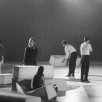Conceptual Correlations of Sound and Image
1 From the Work to the Idea: Protoconcepts and New Music
To aspire to characterize the connections between sound and image in conceptual art by reference to specific artworks is necessarily to challenge those established canons that restrict themselves to classifying this trend—which emerged in the 1960s and remained predominant up to the mid-1970s—in terms of visual art.[1] The importance of the term
If one considers the interconnections of postwar avant-garde movements in the visual arts and New Music, the historiographic problem of clearly delimiting the bounds of conceptual art becomes particularly obvious. The reception given John Cage, La Monte Young, and Steve Reich in particular demonstrates that links between conceptual art and the musical and performative practices that predated or paralleled it were not limited to the circles associated with Fluxus and minimal art. The Judson Dance Theater was to revive works of New Music, such as those of Erik Satie, on the contemporary art scene. Such ongoing interaction and exchange are evident particularly in New York’s art, music, dance, and film scenes of the time, which are the primary focus of this article. The choreographic works of Trisha Brown, Simone Fortis, Steve Paxton, and Yvonne Rainer demonstrate what may be called protoconceptual analogies with musical notation.
People: Trisha Brown, John Cage, Henry Flynt, Simone Forti, Steve Paxton, Yvonne Rainer, Steve Reich, Erik Satie, La Monte Young
Socialbodies: Judson Dance Theater





